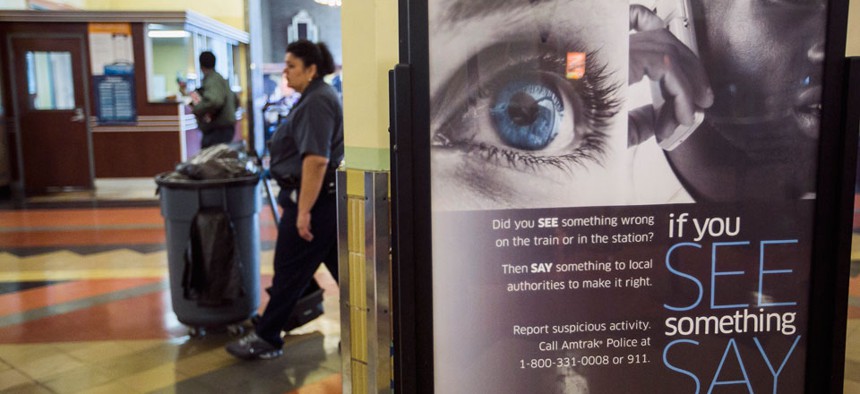See Something Say Something Has Aided 2,000 Probes, But How Many Arrests?

Damian Dovarganes/AP
Public data sets outlining counterterrorism results could help the program shake off a bad rep, advisers say.
Reports of suspicious goings-on, encouraged under the "See Something Say Something" public awareness campaign, have contributed to more than 2,000 FBI investigations, bureau officials disclosed.
The figure provided to Nextgov represents one of many data points sought by critics of the reports, who say they violate civil liberties without protecting national security. But the bureau could not provide the number of arrests the probes have yielded. So it is hard to tell whether 2,000 investigations, brought about by tens of thousands of citizen and police reports, is good or bad, the skeptics said.
That the "program has 'led to or enhanced' a number of investigations provides little meaningful information because the investigations may have been preliminary and may have gone nowhere," said Gregory Nojeim, senior counsel at the Center for Democracy and Technology. "It would be much more useful for the government to disclose the number of arrests and convictions that resulted directly from the [program] and that would not have occurred without it."
Performance metrics could help the bureau shake off a reputation for politicized pursuits, some Justice Department consultants said.
"It would be really cool if, taking into account privacy issues," the government let citizens start "looking at the data on all these cases and put them in an open data set," said Paul Wormeli, executive director emeritus of the government-funded Integrated Justice Information Systems Institute. As for the total number of investigations, "why don't we publish that” statistic and “let people know what this has resulted in?" Wormeli advises the government on the suspicious activity reports initiative, or SAR, which began in 2008.
FBI spokeswoman Denise Ballew said in a statement that "SARs entered by FBI, state, local, tribal and other federal partners have led to, or enhanced, over 2,000 FBI investigations." When asked how many arrests the investigations brought about, she was unable to answer: "The FBI does not track arrests based off of SAR data." The bureau uses a variety of procedures and methods in concert with the reports to investigate, reduce and disrupt terrorist activity, Ballew said, adding that she could not comment further.
Bureau officials in March told federal auditors the FBI doesn't tabulate arrests because probe outcomes are recorded in a separate computer system.
Eye-witness accounts collected through See Something, Say Something -- now including text messages from Amtrak train passengers -- are vetted to avoid false leads, program officials say.
The narratives are not circulated until local authorities and federally-funded state "fusion centers" determine they have merit. To protect privacy, the reports do not go into a database, but rather into a state-owned server that authorized users can access through the cloud.
Lack of Transparency
Despite the controls in place, human rights groups say the FBI has yet to prove the value of the program or the integrity of the data.
"The only thing suspicious is the reporter’s interpretation of the person's race or religion," said Michael German, senior policy counsel for the American Civil Liberties Union. "If there were 2,000 investigations that found no wrongdoing, there were 2,000 investigations too many."
ACLU recently obtained report summaries from California, including one that read, "'Suspicious Conversation Overheard': 'The neighbor, one of 4 young clean cut Middle Eastern males, was speaking excitedly in a foreign language.'"
Citizens should be allowed to know the number of arrests stemming from the reports, and "the idea that they don't track them is specious," German said.
Nojeim echoed, "The FBI should be much more transparent about whether the See Something Say Something program has been effective so the public can assess whether counterterrorism dollars could be better spent."
Federal auditors also have chided program officials for not quantifying the results of the reports. During a roughly three-year period, ending in October 2012, the number of submissions skyrocketed from 3,256 to 27,855, according to a March Government Accountability Office review.
"Until the [program] establishes a performance management plan that includes measures that assess what difference the [reports] are making in terms of thwarting threats or resulting in arrests or convictions -- [program officials] lack a means for establishing accountability for ensuring measures are implemented," GAO officials stated.
In response to a draft report, Justice officials said they will work on creating metrics that illustrate the effect of the program on homeland security.
A few stories about arrests have been made public. One anecdote involves two Marines traveling through Seattle in a government vehicle who saw a male motorist note their government license plates and then attempt to run them off the road. The Marines told their commanding officer, who in turn forwarded a report to the Washington State Fusion Center. From there, authorities identified the motorist as someone who had been in contact with a suspect charged for plotting to attack a Seattle military facility. The motorist was subsequently arrested for assaulting the Marines.
![]()
NEXT STORY: Social media: The next generation of archiving






